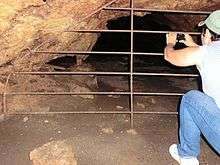Paraguana moustached bat
The Paraguana moustached bat (Pteronotus paraguanensis) occurs only on the Paraguaná Peninsula of Venezuela.[1] The entire population uses three caves, one of which is subject to human vandalism.[1] Their total range is less than 400 km2 (150 sq mi).[1] In 2008, the caves where the bat is found were protected by the creation of the Cuevas de Paraguaná Wildlife Sanctuary–the first wildlife sanctuary in Venezuela.[2]
| Paraguana moustached bat | |
|---|---|
| Scientific classification | |
| Kingdom: | Animalia |
| Phylum: | Chordata |
| Class: | Mammalia |
| Order: | Chiroptera |
| Family: | Mormoopidae |
| Genus: | Pteronotus |
| Species: | P. paraguanensis |
| Binomial name | |
| Pteronotus paraguanensis (Linares & Ojasti, 1974) | |
| Synonyms | |
| |
Taxonomy
There is uncertainty if this taxa represents a species, or if it is a subspecies of Parnell's mustached bat.[1] Based on morphology, the bats were elevated from a subspecies to a species in 2008.[3] The status of the bat as a full species was affirmed by genetic sequencing.[4]
Conservation

In their 2008 assessment, the IUCN listed the Paraguana moustached bat as critically endangered.[1] The 2016 assessment, however, downlisted them to endangered.[1] In 2013, Bat Conservation International listed this species as one of the 35 species of its worldwide priority list of conservation.[5] In 2015, Bat Conservation International began fundraising for bat detectors to better survey the critical habitat necessary for the species' survival.[6] The species is especially threatened by intentional destruction by humans; in 1997, thousands of dead bats were found in one of the caves after locals set tires on fire at the cave entrance.[3] Some Venezuelans mistakenly believe that all bats are vampire bats, and should therefore be exterminated.[3] To reduce vandalism and protect the bats, a gate was installed in 2003 at the entrance of one of the caves, with gaps large enough for bats to come and go, but too small for human passage.[3] After the gate was installed, the number of bats using the cave "substantially increased".[3]
References
- Solari, S. 2016. Pteronotus paraguanensis. The IUCN Red List of Threatened Species 2016: e.T136610A21987754. https://dx.doi.org/10.2305/IUCN.UK.2016-1.RLTS.T136610A21987754.en. Downloaded on 04 May 2017.
- "Cuevas de Paraguaná". diversidadbiologica.minamb.gob.ve. Diversidad Biológica. Retrieved May 6, 2017.
- Eliécer E. Gutiérrez, Jesús Molinari; Morphometrics and Taxonomy of Bats of the Genus Pteronotus (Subgenus Phyllodia) in Venezuela. J Mammal 2008; 89 (2): 292-305.
- Pavan, A. C., & Marroig, G. (2016). Integrating multiple evidences in taxonomy: species diversity and phylogeny of mustached bats (Mormoopidae: Pteronotus). Molecular Phylogenetics and Evolution, 103, 184-198.
- "Annual Report 2013-2014" (PDF). batcon.org. Bat Conservation International. August 2014. Archived from the original (PDF) on July 7, 2017. Retrieved May 1, 2017.
- "The BCI Wish List". batcon.org. Bat Conservation International. Winter 2015. Retrieved May 6, 2017.
